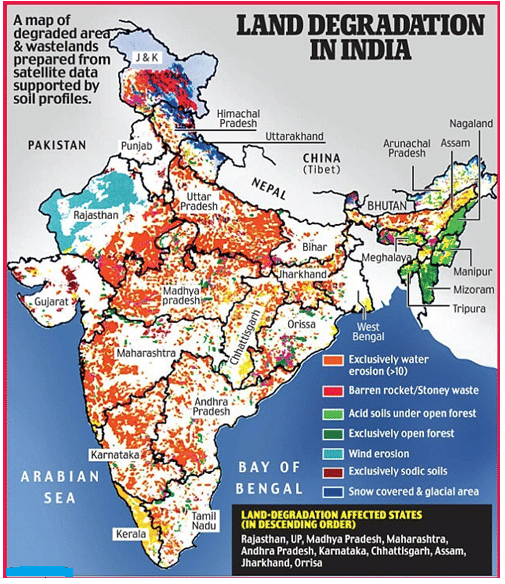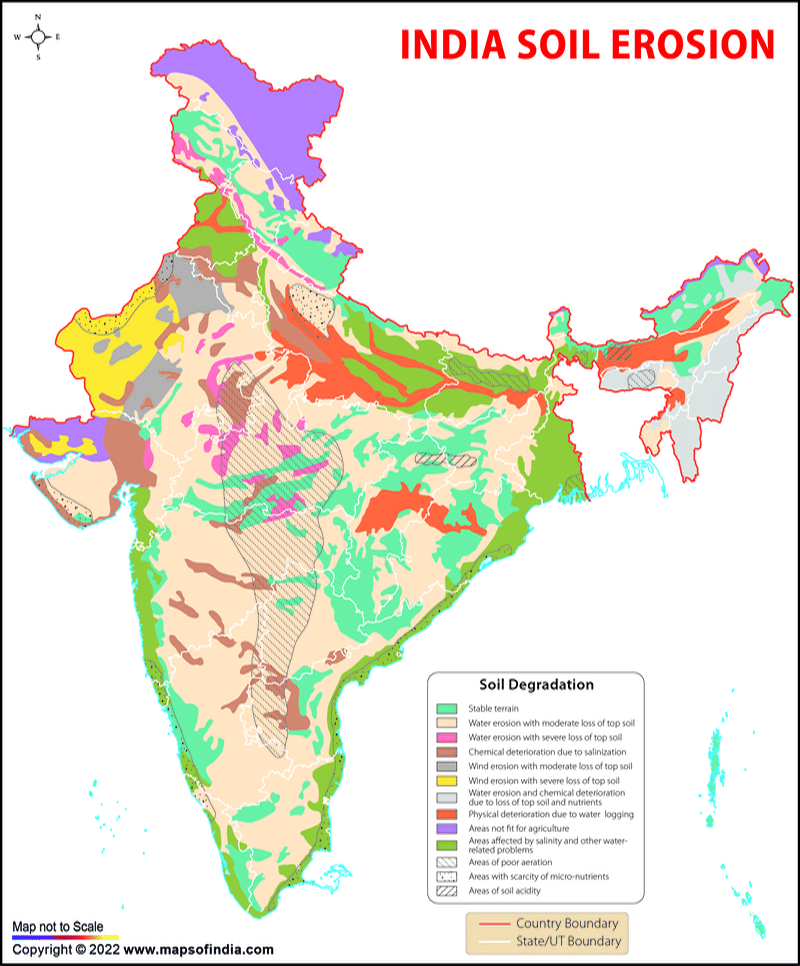Soil Erosion and its Management - 1 | NABARD Grade A & Grade B Preparation - Bank Exams PDF Download
Soil Degradation in India
Soil Degradation is the term used to describe the deterioration of soil quality and fertility. It can occur due to several factors, including a decrease in nutrient levels, a reduced population of essential microorganisms like earthworms, changes in soil structure, shifts in pH levels (alkalinity or acidity), and the introduction of harmful elements and pollutants. Actions like the movement of animals or the removal of the upper soil layers by human activities can contribute to soil degradation.
Impact on Soil Resources
Soil degradation plays a substantial role in the depletion of India's soil resource base. The degree of soil degradation differs from one region to another due to various factors such as topography, wind patterns, rainfall, and human actions. Soil degradation includes several aspects, such as soil erosion, physical degradation, chemical degradation, and biological degradation.
Soil Erosion
Soil erosion is the process of soil being carried away more quickly than it can be naturally replaced by erosion-related mechanisms. Although soil creation and erosion usually happen concurrently, external factors, whether natural or human-induced, can upset this equilibrium, ultimately leading to a net loss of soil. Human actions, including activities like deforestation, excessive grazing, and specific land drainage projects, frequently expedite the natural erosion processes.
Causes
Soil erosion is affected by a variety of factors including topography, rainfall, wind, vegetation cover, and land use practices. The nature of the terrain and steep slopes can enhance erosion rates by facilitating water flow and soil movement. Climate elements like wind and rainfall are significant agents of soil erosion, with wind erosion being more pronounced in arid and semi-arid regions, while water erosion is predominant in areas with heavy rainfall.
- Water erosion typically occurs in two primary forms: sheet erosion and gully erosion. Sheet erosion transpires when the topsoil is gradually washed away, typically on flat terrains following intense rainfall. On the other hand, gully erosion transpires when runoff carves deep gullies, often found on steep slopes. These gullies can deepen with each rainfall, fragmenting agricultural lands and rendering them unfit for cultivation. Regions characterized by an abundance of deep gullies or ravines are referred to as having a "badland topography." The Chambal Valley in Madhya Pradesh is a notable example of gully erosion, with instances also recorded in Tamil Nadu and West Bengal.
- Soil eroded through erosion is transported downstream into rivers, reducing their capacity to carry water, leading to frequent flooding, and causing damage to agricultural lands. Coastal areas are also susceptible to soil erosion resulting from tidal waters from the Arabian Sea and the Bay of Bengal. Severe erosion of beaches along the coasts of Kerala, Tamil Nadu, Odisha, West Bengal, and Gujarat illustrates this form of sea-wave erosion.
- Deforestation significantly contributes to soil erosion, particularly affecting hilly regions throughout the country. Additionally, intensive agricultural practices that heavily rely on water and chemical fertilizers have led to waterlogging and salinity problems in various parts of the country. This has resulted in a long-term decrease in soil fertility, particularly evident in river valley projects that initially benefited from the Green Revolution. Approximately half of India's land area is estimated to be undergoing some degree of degradation as a result of these factors.
Erosion Processes
Soil erosion can manifest in different ways, such as splash erosion (caused by raindrops impacting bare soil), sheet erosion (the removal of the finer topsoil on level terrain following heavy rainfall), rill erosion (the development of small channels), and gully erosion (the creation of deep gullies that make agricultural land unsuitable for farming).

Vegetation and Land Use Practices
The presence of vegetation is of paramount importance in mitigating soil erosion. In undisturbed forests, erosion rates are minimal because the vegetation serves to intercept and disperse the energy of raindrops and wind, and the roots of plants actively anchor soil particles, enhancing soil stability and making it more resistant to erosion. On the contrary, human land use practices, such as agriculture and pastoral activities, can exacerbate erosion, especially when the soil is frequently plowed, left exposed without protective plant cover, or subjected to excessive grazing and over-irrigation.
|
847 videos|1297 docs|420 tests
|
















